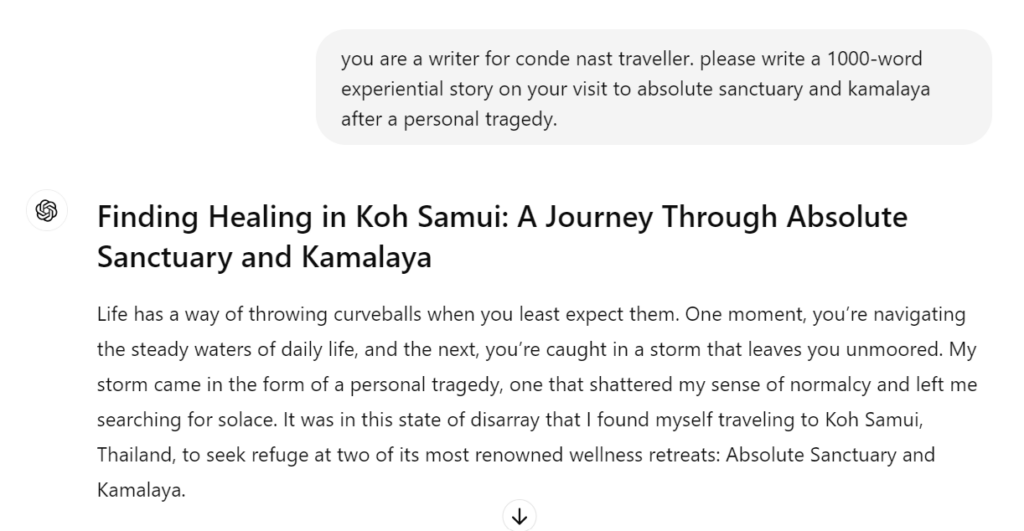I don’t want to alarm you, but there’s a new arms race underway.
On one side, says academic and Youtuber Dr Andrew Stapleton, are artificial intelligence (AI) content creation tools like ChatGPT, Midjourney, JasperAI and OwlyWriter AI; on the other are AI content detection tools such as GPTZero, Hive, Originality.ai and Smodin.
Stuck in the middle are writers. They’ve already lost work opportunities to bots – with one study finding a 21% decrease in jobs posted to online freelance platforms within eight months of the introduction of ChatGPT.
Frankly, though, that’s the least of our worries.
The rapid rise of AI content detection tools
ChatGPT was launched on November 30, 2022.
In its wake, an explosion in AI-generated content followed, much of it slop.
Most competent writers (and readers) can identify AI-generated content.
Even if you can’t articulate the individual telltale signs, a piece of writing just sounds off.
Nevertheless, many publications, companies, brands and other commissioning organisations have sought to protect the integrity of their image and operations by running the work that their writers submit through AI content detection tools.
The result? Writers have been getting canned when AI content detection tools (falsely) flag their work as AI-generated.
Could AI content detection tools get you fired?
If you think you’re safe because you don’t use ChatGPT, think again.
Even if you’ve never experimented with these tools, you still risk your work being flagged as AI-generated. That’s due to an unacceptably high rate of false positives, one study found.
Another study concluded that AI content detection tools were “neither accurate nor reliable” and were vulnerable to “obfuscation techniques” such as manual editing or machine paraphrasing (though the authors were more concerned, in this instance, with academic plagiarism).
So, what’s a writer to do?
In a world awash with AI and tools designed to tame the very beast that’s been unleashed, there are ways to make your work stand out, or (just as importantly) to avoid being unjustly accused of using AI to create it.
If you’re so inclined, you can even use the tips below to outsmart AI content detection tools.
This will, admittedly, require a considerable amount of work from you.
So you might as well create original content from the start, no?

How can I flag my work as human-generated?
There are many ways to establish that your work is utterly your own. Here are the top 5 methods.
Lead with original research
It almost goes without saying that unless you’re bringing something new to the table, you have no business writing a word. Original research is time-consuming – but so much more compelling than the second- and third-hand stuff that’s already done the rounds.
Original research comes in many forms. It might be a just-published research study, a survey, a new case study, or the uncovering of a dodgy set of dealings which merits further investigation. Original research might include a visit to a new facility that sparks curiosity, or your account of a tour that’s never been written about previously.
Original research might involve a perspective-shifting synthesis or analysis of existing facts. ChatGPT can only spit back information published prior to July 2023 (at the time of writing). If you’re first with the news, it’s difficult for anyone to make the case that your work is AI-generated.

Here are my top 5 methods for coming up with unique story ideas no bot can match.
Conduct your own interviews
A UTS study estimated that up to three-quarters of all mass media content today is provided or significantly influenced by public relations practitioners. This is one reason why there’s often a sudden flurry of coverage on the same destination, product or issue. Avoid drinking too heavily from the village well.
AI can scrape data from news articles and press releases that appear on the web, but it can’t conduct nuanced interviews or otherwise embark on its own independent news gathering expeditions. This means that conducting an interview with a subject who hasn’t appeared in the media a million times before – or going off-piste on a press trip, as I love to do – is likely to net you valuable one-of-a-kind insights, quotes and perspectives. Seek out your own subject matter experts to add depth and credibility to your work. Train your contacts to come to you before the press release goes out.
Whatever you do, don’t rely on sources or references quoted by ChatGPT and its ilk. They have no compunction about making stuff up. One study found that the chatbot ‘hallucinated’ when asked to nominate its scientific sources, in that “none of the provided paper titles existed, and all provided PubMed IDs (PMIDs) were of different unrelated papers”. It has cited non-existent legal cases, to the chagrin of the lawyer who took them to court and was fined for their trouble. It has even generated fake quotes by imaginary people, including Jane Doe.
Leaven with humour
There are very few stories – even serious ones – which wouldn’t benefit from some levity. And there’s no faster way to flag your work as human-generated than by sprinkling it with humour. AI doesn’t – and can’t – do funny. The incongruity theory of humour holds that mismatches between our expectations and reality make us laugh. But because the large language models (LLMs) which underpin generative AI products rely on the logical next word prediction process, they can’t make the playful leaps that take an audience by surprise. AI can churn out jokes that are already circulating on the Internet. It just can’t generate its own.
I’ve previously written about my experiment asking ChatGPT to write a humorous 100-word caption about bathing in hot springs in the Queensland outback for my Instagram account. The delightfully named research paper A robot walks into a bar conducted a more thorough review of the state of AI-generated humour. The researchers interviewed 20 professional comedians who participated in workshops designed to help them harness AI in their artistic process during the Edinburgh Festival Fringe in August 2023. Overall, they concluded that AI was a poor assistant, as it produced “bland biased comedy tropes, akin to ‘cruise ship comedy material from the 1950s, but a bit less racist’.”
Inject creativity and personal experience
ChatGPT and similar engines have access to a vast corpus (database) of information that far exceeds anything even a polymath could hold in mind. If these bots have been trained exclusively on factually correct materials – and that’s a very big if* – they’re able to generate passable, functional pieces of writing which provide sometimes very detailed data for information purposes. ChatGPT has thus breezed through the United States Medical Licensing Exam (USMLE), the Uniform Bar Examination (with a score approaching the 90th percentile) and the CPA exam (albeit on its second attempt).
ChatGPT can create nonfiction, but not creative nonfiction. It struggles to share the sort of personal anecdotes and first-hand experiences which enhance theme and illuminate meaning. So writing the story only you can tell is more timely advice than ever. AI can’t handle character development or narrative arcs. Its metaphors, analogies, and examples – if they exist at all – tend towards cackhandedness. Unable to go deep, incapable of excavating real emotion, AI skims the surface and evokes that eerie, unsatisfying sense that you’ve just taken a long lonely hike down Uncanny Valley.
Take this achingly beautiful story by Chloe Bottero. As I read it, my heart went out to her. I tried (and predictably failed) to replicate it using ChatGPT. There are elements which combine to produce a pale facsimile of a story, but it’s light on the details. For instance, we never find out what the ‘personal tragedy’ was, because ChatGPT has no clue. See the first paragraph below.

* Even ChatGPT knows its limits, with a disclaimer under the input field saying ‘ChatGPT can make mistakes. Check important info.’

Avoid repetition
Writers all have their pet turns of phrase. “Pass in a blur” is, oddly, one of mine. I’m sure Sigmund Freud would have a field day with it. I must consciously avoid “pass in a blur” now when summarising the passage of time. Yet ChatGPT takes this to a whole new level, with a collection of favourites so predictable as to warrant their own Reddit thread. These include “It’s important to note”, “Remember that” and “Delve into”. And, boy, does it love, “In conclusion”.
AI content detection tools are trained to recognise patterns, so getting rid of the overused keywords and phrases, provides a quick way to bypass the AI content detection tool – and to provide your reader with a more pleasurable experience. It can be difficult to pick up the repetition in your own writing when you’ve been working on it for an extended period. Rest, if you can, before picking it up again. (For other compelling reasons to rest, click here.) If a deadline is looming, and I don’t have time to set a story aside for a few days, I use the ‘Read Aloud’ function in Word to pick up repetitive words and phrases. The ear can often pick up what the eyes no longer detect.
Over to you …
Have you ever been accused of using AI when you didn’t?
While you’re here …
Sign up for my newsletter. You’ll also receive a FREE copy of Pitching for Publication which deconstructs three pitches which have won me writing assignments and ongoing professional relationships with editors.
